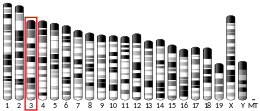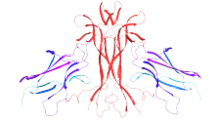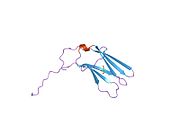트로포모신 수용체 키나아제 A
Tropomyosin receptor kinase A고친화성 신경성장인자 수용체, 신경계통 티로신 키나아제 수용체 유형 1 또는 TRK1-변환형 티로신 키나제 단백질로 알려진 [5]트로포미오신 수용체 키나제 A(TrkA)는 인간에서 NTRK1 유전자에 의해 암호화된 단백질이다.[6]
이 유전자는 신경계 티로신키나제수용체(NTKR) 계열의 부재를 암호로 한다.이 키나아제는 세포막 결합 수용체로, 신경트로핀 결합 시 인산염 자체(자인산화)와 MAPK 경로의 구성원이 된다.이 키나제의 존재는 세포 분화를 초래하고 감각 뉴런의 아형을 명시하는 역할을 할 수 있다.이 유전자의 돌연변이는 선천성 통증 불감증, 자기 교란 행위, 지적 장애 및/또는 인지 장애, 특정 암과 관련이 있다.이 유전자의 대체 전사적 스플라이스 변형이 발견되었지만 현재까지 3개만 특징지어졌다.[7]
함수 및 NGF와의 상호작용
TrkA는 신경트로핀, 신경성장인자 또는 'NGF'의 고친화도 촉매 수용체로 키나제로서 신경분화, 신경확산, nociceptor 반응, 프로그래밍된 세포사멸 회피 등을 포함하는 NGF의 다중효과를 매개한다.[8]
TrkA에 대한 NGF의 결합은 리간드에 의한 조광화를 초래하며, 이 수용체와 리간드가 상호작용하는 제안 메커니즘은 두 개의 TrkA 수용체가 단일 NGF 리간드와 연관되는 것이다.[9]이러한 상호작용은 TrkA의 리간드 바인딩 도메인의 일부가 각각의 리간드와 연관되어 있는 조광 복합체를 교차 연결하는 결과로 이어진다.[9]TrkA는 세포외 부분에 5개의 결합 도메인을 가지고 있으며, TrkA-d5 도메인은 NGF의 결합에 중요하고 적절한 면역글로불린과 같은 영역으로 접힌다.[10]NGF에 의해 즉시 결합한 후, NGF/TrkA 콤플렉스는 시냅스에서 내분포를 통해 세포체까지 가져와 NGF 의존적 전사 프로그램을 활성화한다.[9]활성화 시, 티로신 잔여물은 TrkA의 세포질 영역 내에서 인산염화되며, 이러한 잔류물은 뉴런의 분화와 생존을 이끄는 몇 가지 경로를 따라 신호 분자를 모집한다.[11]이 복합체가 성장을 촉진하기 위해 작용하는 두 가지 경로는 Ras/MAPK 경로와 PI3K/Akt 경로를 통해서이다.[9]
가족구성원
3개의 트랜섬브레인 수용체 TrkA, TrkB, TrkC(각각 NTRK1, NTRK2, NTRK3 유전자에 의해 인코딩됨)는 Trk 수용체군을 구성한다.[12]이 수용체 집단은 모두 단백질 신경 성장 인자, 즉 신경세포에 의해 활성화된다.또한 구조적으로 NGF와 관련된 다른 신경퇴행 요인도 있다: BDNF(뇌유래 신경퇴행성인자의 경우), NT-3(신경종양인-3의 경우), NT-4(신경종양인-4의 경우)이다.TrkA가 NGF의 효과를 매개하는 반면, TrkB는 BDNF, NT-4, NT-3에 의해 결합되고 활성화된다.또한, TrkC는 NT-3에 의해 결합되고 활성화된다.[13]한 연구에서, Trk 유전자는 배아 쥐 줄기 세포에서 제거되었고, 이것은 심각한 신경 질환을 유발했고, 대부분의 쥐들이 태어난 지 한 달 후에 죽게 했다.[14]따라서 trk는 NGF의 발달과 성장 과정의 중재자로, 많은 유기체에서 신경계 발달에 중요한 역할을 한다.
TrkA 외에 다른 NGF 수용체가 하나 있는데, "LNGFR"("저선호도 신경 성장 인자 수용체"의 경우)로 불린다.TrkA와는 반대로, LNGFR은 NGF 생물학에서 다소 덜 명확한 역할을 한다.일부 연구자들은 LNGFR이 신경트로핀의 "싱크" 역할을 한다는 것을 보여주었다.따라서 LNGFR 수용체와 Trk 수용체를 모두 표현하는 세포는 신경트로핀의 "마이크로 농도"가 높기 때문에 더 큰 활성을 가질 수 있다.그러나, 공동 표현 TrkA가 없을 경우, LNGFR은 세포 사멸을 통해 죽는 신호를 보낼 수 있으므로, Trk 수용체가 없을 때 LNGFR을 발현하는 세포는 신경트로핀의 존재에서 살기보다는 죽을 수 있다는 것도 밝혀졌다.
질병에서의 역할
다양한 질병에서 TrkA의 역할을 강조하는 여러 연구가 있다.[15]두 개의 랫드 모델에 대해 실시된 한 연구에서, AR786으로 TrkA를 억제하면 관절 붓기, 관절 손상, 염증성 관절염으로 인한 통증 등이 감소하였다.[15]따라서 NGF의 결합을 차단하면 유전성 관절염으로 인한 부작용을 완화할 수 있으며, 잠재적으로 인간의 염증성 관절염에 도움이 되는 모델을 강조할 수 있다.[15]
기능장애를 가진 환자들을 대상으로 한 한 한 연구에서 과학자들은 위 점막에서 TrkA와 신경 성장 인자가 크게 증가한 것을 발견했다.[16]TrkA와 신경 성장 인자의 증가는 환자의 소화불량 및 위 증상과 연관되어 있으므로 이러한 증가는 기능적 난독증의 발현과 연관되어 있을 수 있다.[16]
한 연구에서 각막의 영향을 받는 각막에서 TrkA 수용체의 총 부재가 발견되었고, Sp3 전사 인자의 억제기 등소형도 증가하였다.[17]
NTRK1과 관련된 유전자 결합은 인공적인 것으로 나타나 TrkA의 구성적 활성화를 이끌었다.[18]Vaishnavi A. 외 연구팀의 연구에서 NTRK1 용액은 차세대 염기서열 분석 또는 상황혼합에서의 형광을 통해 평가된 폐암의 3.3%에서 발생하는 것으로 추정되었다.[18]
어떤 맥락에서, Trk A는 인공적인 반면, 다른 맥락에서 TrkA는 암세포에서 말기 분화를 유도하여 세포 분열을 중단시키는 능력을 가지고 있다.신경블라스토마와 같은 일부 암에서는 TrkA가 자연발생적 종양 퇴행과 연관되어 있기 때문에 좋은 예후 지표로 보여진다.[19]
규정
구별되는 단백질의 수준은 "유비퀴틴/단백질" 시스템에 의해 조절될 수 있다.이 시스템에서는 "유비퀴틴"이라고 불리는 작은(7~8 kd) 단백질을 표적 단백질에 부착하고, 따라서 "단백질"이라고 불리는 구조물에 의해 파괴의 대상이 된다.TrkA는 NEDD4-2라고 불리는 "E3 ubiquitin ligase"에 의한 프로테아솜 매개 파괴의 표적이다.[20]이 메커니즘은 뉴런의 생존을 조절하는 뚜렷한 방법이 될 수 있다.TrkA 편재화의 범위와 유형은 NGF, p75NTR에 대해 관련이 없는 다른 수용체에 의해 규제될 수 있다.
상호작용
TrkA는 다음과 상호작용하는 것으로 나타났다.
리간즈
아미트립티라인과 감보그산 유도체 같은 작은 분자가 TrkA를 활성화시킨다고 주장되어 왔다.아미트리프라인은 TrkA를 활성화하고 NGF가 없는 경우 TrkA와 TrkB의 이질화를 촉진한다.TrkA에 대한 아미트리프라인의 결합은 수용체의 세포외 영역의 Leucine Rich 영역(LRR)에 발생하며, NGF 결합 부위와 구별된다.아미트리프틸린은 인비트로와 인비보(마우스 모델) 모두 신경퇴행성을 가지고 있다.[37]감보그산의 파생물질인 감보그 아미드는 TrkA의 세포질 헥스타엠브레인 영역과 상호 작용하여 인비트로와 인비보 모두를 선택적으로 활성화시킨다.[38]
암에서의 역할
TrkA는 암에서 이중 역할을 맡고 있다.TrkA는 원래 대장종양에서 복제되었다; 그 암은 번역에 의해 발생했고, 그 결과 TrkA kinase 도메인이 활성화되었다.Although originally identified as an oncogenic fusion in 1982,[39] only recently has there been a renewed interest in the Trk family as it relates to its role in human cancers because of the identification of NTRK1 (TrkA), NTRK2 (TrkB) and NTRK3 (TrkC) gene fusions and other oncogenic alterations in a number of tumor types.인간 트렉 종양 유전자의 활성화 메커니즘은 키나제 영역의 접힘과 관련된 것으로 의심되어 수용체가 구성적으로 활성 상태를 유지하도록 한다.[40]이와는 대조적으로, Trk A는 또한 유아에게 암의 분화와 자발적 퇴행을 유도할 수 있는 잠재력을 가지고 있다.[19]
개발억제제
FDA 승인을 받은 몇몇 Trk 억제제가 있으며, 임상적으로 Trk 억제제 역할을 함으로써 Trk 과표현 효과를 상쇄시키는 것으로 관찰되었다.[41]
엔트레티닙(옛 RXDX-101)은 이그니타(Ignyta, Inc.)에서 개발한 조사용 약물로, 잠재적 항균작용이 있다.현재 2상 임상시험 중인 trkA, trkB, trkC(NTRK1, NTRK2, NTRK3 유전자에 의해 부호화됨)의 유전자 퓨즈를 대상으로 하는 선택적 범트렉 수용체 tyrosine kinase 억제제(TKI)이다.[42]
"라로트레티닙"은 모든 Trk 수용체(TrkA, TrkB, TrkC)에 대한 억제제로서, 이 약물은 Trk fusion을 가진 종양의 치료제로 사용된다.[12]이 약의 효능을 분석한 임상연구 결과 라로트레티닙은 효과적인 항종양 치료제였으며, 환자의 연령이나 종양 타입에 관계없이 효율적으로 효과가 있었으며, 또한 오랫동안 지속되는 부작용이 없어 트렉퓨전 치료에 있어 이 약의 유익한 사용을 강조하였다.[12]
참조
- ^ a b c GRCh38: 앙상블 릴리스 89: ENSG00000198400 - 앙상블, 2017년 5월
- ^ a b c GRCm38: 앙상블 릴리스 89: ENSMUSG000028072 - 앙상블, 2017년 5월
- ^ "Human PubMed Reference:". National Center for Biotechnology Information, U.S. National Library of Medicine.
- ^ "Mouse PubMed Reference:". National Center for Biotechnology Information, U.S. National Library of Medicine.
- ^ Malenka RC, Nestler EJ, Hyman SE (2009). "Chapter 8: Atypical neurotransmitters". In Sydor A, Brown RY (eds.). Molecular Neuropharmacology: A Foundation for Clinical Neuroscience (2nd ed.). New York: McGraw-Hill Medical. ISBN 9780071481274.
Another common feature of neurotrophins is that they produce their physiologic effects by means of the tropomyosin receptor kinase (Trk) receptor family (also known as the tyrosine receptor kinase family). ...
Trk receptors
All neurotrophins bind to a class of highly homologous receptor tyrosine kinases known as Trk receptors, of which three types are known: TrkA, TrkB, and TrkC. These transmembrane receptors are glycoproteins whose molecular masses range from 140 to 145 kDa. Each type of Trk receptor tends to bind specific neurotrophins: TrkA is the receptor for NGF, TrkB the receptor for BDNF and NT-4, and TrkC the receptor for NT-3.However, some overlap in the specificity of these receptors has been noted. - ^ Martin-Zanca D, Hughes SH, Barbacid M (April 1986). "A human oncogene formed by the fusion of truncated tropomyosin and protein tyrosine kinase sequences". Nature. 319 (6056): 743–8. Bibcode:1986Natur.319..743M. doi:10.1038/319743a0. PMID 2869410. S2CID 4316805.
- ^ "Entrez Gene: NTRK1 neurotrophic tyrosine kinase, receptor, type 1".
- ^ Martin-Zanca D, Hughes SH, Barbacid M (2016). "A human oncogene formed by the fusion of truncated tropomyosin and protein tyrosine kinase sequences". Nature. 319 (6056): 743–8. doi:10.1136/annrheumdis-2014-207203. PMID 2869410.
- ^ a b c d Stoleru B, Popescu A, Tache D, Neamtu O, Emami G, Tataranu L, Buteica A, Dricu A, Purcaru S (2013). "Tropomyosin-Receptor-Kinases Signaling in the Nervous System". Maedica. 8 (1): 43–48. PMC 3749761. PMID 24023598.
- ^ a b Wiesmann C, Ultsch MH, Bass SH, de Vos AM (September 1999). "Crystal structure of nerve growth factor in complex with the ligand-binding domain of the TrkA receptor". Nature. 401 (6749): 184–8. Bibcode:1999Natur.401..184W. doi:10.1038/43705. PMID 10490030. S2CID 4337786.
- ^ Marlin MC, Li G (2015). "Biogenesis and function of the NGF/TrkA signaling endosome". International Review of Cell and Molecular Biology. 314: 239–57. doi:10.1016/bs.ircmb.2014.10.002. ISBN 9780128022832. PMC 4307610. PMID 25619719.
- ^ a b c McPhail CW (December 1965). "Current advances in public health dentistry". Canadian Journal of Public Health. 56 (12): 512–6. doi:10.1056/NEJMoa1714448. PMC 5857389. PMID 29466156.
- ^ Benito-Gutiérrez E, Garcia-Fernàndez J, Comella JX (February 2006). "Origin and evolution of the Trk family of neurotrophic receptors". Molecular and Cellular Neurosciences. 31 (2): 179–92. doi:10.1016/j.mcn.2005.09.007. PMID 16253518. S2CID 25232377.
- ^ Smeyne RJ, Klein R, Schnapp A, Long LK, Bryant S, Lewin A, et al. (March 1994). "Severe sensory and sympathetic neuropathies in mice carrying a disrupted Trk/NGF receptor gene". Nature. 368 (6468): 246–9. Bibcode:1994Natur.368..246S. doi:10.1038/368246a0. PMID 8145823. S2CID 4318721.
- ^ a b c Ashraf S, Bouhana KS, Pheneger J, Andrews SW, Walsh DA (May 2016). "Selective inhibition of tropomyosin-receptor-kinase A (TrkA) reduces pain and joint damage in two rat models of inflammatory arthritis". Arthritis Research & Therapy. 18 (1): 97. doi:10.1186/s13075-016-0996-z. PMC 4857260. PMID 27145816.
- ^ a b Shi H, Zhu S, Qin B, Wang L, Yang J, Lu G, Dai F (December 2019). "Nerve growth factor and Tropomyosin receptor kinase A are increased in the gastric mucosa of patients with functional dyspepsia". BMC Gastroenterology. 19 (1): 221. doi:10.1186/s12876-019-1133-7. PMC 6924065. PMID 31856738.
- ^ Lambiase A, Merlo D, Mollinari C, Bonini P, Rinaldi AM, D' Amato M, et al. (November 2005). "Molecular basis for keratoconus: lack of TrkA expression and its transcriptional repression by Sp3". Proceedings of the National Academy of Sciences of the United States of America. 102 (46): 16795–800. Bibcode:2005PNAS..10216795L. doi:10.1073/pnas.0508516102. PMC 1283852. PMID 16275928.
- ^ a b Vaishnavi A, Capelletti M, Le AT, Kako S, Butaney M, Ercan D, et al. (November 2013). "Oncogenic and drug-sensitive NTRK1 rearrangements in lung cancer". Nature Medicine. 19 (11): 1469–1472. doi:10.1038/nm.3352. PMC 3823836. PMID 24162815.
- ^ a b Brodeur GM, Minturn JE, Ho R, Simpson AM, Iyer R, Varela CR, Light JE, Kolla V, Evans AE (May 2009). "Trk receptor expression and inhibition in neuroblastomas". Clinical Cancer Research. 15 (10): 3244–50. doi:10.1158/1078-0432.CCR-08-1815. PMC 4238907. PMID 19417027.
- ^ Yu T, Calvo L, Anta B, López-Benito S, Southon E, Chao MV, et al. (April 2011). "Regulation of trafficking of activated TrkA is critical for NGF-mediated functions". Traffic. 12 (4): 521–34. doi:10.1111/j.1600-0854.2010.01156.x. PMC 3547592. PMID 21199218.
- ^ a b c d Koch A, Mancini A, Stefan M, Niedenthal R, Niemann H, Tamura T (March 2000). "Direct interaction of nerve growth factor receptor, TrkA, with non-receptor tyrosine kinase, c-Abl, through the activation loop". FEBS Letters. 469 (1): 72–6. doi:10.1016/S0014-5793(00)01242-4. PMID 10708759.
- ^ Yano H, Cong F, Birge RB, Goff SP, Chao MV (February 2000). "Association of the Abl tyrosine kinase with the Trk nerve growth factor receptor". Journal of Neuroscience Research. 59 (3): 356–64. doi:10.1002/(SICI)1097-4547(20000201)59:3<356::AID-JNR9>3.0.CO;2-G. PMID 10679771.
- ^ a b c Meakin SO, MacDonald JI, Gryz EA, Kubu CJ, Verdi JM (April 1999). "The signaling adapter FRS-2 competes with Shc for binding to the nerve growth factor receptor TrkA. A model for discriminating proliferation and differentiation". The Journal of Biological Chemistry. 274 (14): 9861–70. doi:10.1074/jbc.274.14.9861. PMID 10092678.
- ^ Song C, Perides G, Liu YF (February 2002). "Expression of full-length polyglutamine-expanded Huntingtin disrupts growth factor receptor signaling in rat pheochromocytoma (PC12) cells". The Journal of Biological Chemistry. 277 (8): 6703–7. doi:10.1074/jbc.M110338200. PMID 11733534.
- ^ MacDonald JI, Gryz EA, Kubu CJ, Verdi JM, Meakin SO (June 2000). "Direct binding of the signaling adapter protein Grb2 to the activation loop tyrosines on the nerve growth factor receptor tyrosine kinase, TrkA". The Journal of Biological Chemistry. 275 (24): 18225–33. doi:10.1074/jbc.M001862200. PMID 10748052.
- ^ Yamashita H, Avraham S, Jiang S, Dikic I, Avraham H (May 1999). "The Csk homologous kinase associates with TrkA receptors and is involved in neurite outgrowth of PC12 cells". The Journal of Biological Chemistry. 274 (21): 15059–65. doi:10.1074/jbc.274.21.15059. PMID 10329710.
- ^ Nykjaer A, Lee R, Teng KK, Jansen P, Madsen P, Nielsen MS, et al. (February 2004). "Sortilin is essential for proNGF-induced neuronal cell death". Nature. 427 (6977): 843–8. Bibcode:2004Natur.427..843N. doi:10.1038/nature02319. PMID 14985763. S2CID 4343450.
- ^ Lee R, Kermani P, Teng KK, Hempstead BL (November 2001). "Regulation of cell survival by secreted proneurotrophins". Science. 294 (5548): 1945–8. Bibcode:2001Sci...294.1945L. doi:10.1126/science.1065057. PMID 11729324. S2CID 872149.
- ^ Ohmichi M, Decker SJ, Pang L, Saltiel AR (August 1991). "Nerve growth factor binds to the 140 kd trk proto-oncogene product and stimulates its association with the src homology domain of phospholipase C gamma 1" (PDF). Biochemical and Biophysical Research Communications. 179 (1): 217–23. doi:10.1016/0006-291X(91)91357-I. hdl:2027.42/29169. PMID 1715690.
- ^ a b c d Qian X, Riccio A, Zhang Y, Ginty DD (November 1998). "Identification and characterization of novel substrates of Trk receptors in developing neurons". Neuron. 21 (5): 1017–29. doi:10.1016/S0896-6273(00)80620-0. PMID 9856458. S2CID 12354383.
- ^ a b Nakamura T, Komiya M, Sone K, Hirose E, Gotoh N, Morii H, et al. (December 2002). "Grit, a GTPase-activating protein for the Rho family, regulates neurite extension through association with the TrkA receptor and N-Shc and CrkL/Crk adapter molecules". Molecular and Cellular Biology. 22 (24): 8721–34. doi:10.1128/MCB.22.24.8721-8734.2002. PMC 139861. PMID 12446789.
- ^ Wooten MW, Seibenhener ML, Mamidipudi V, Diaz-Meco MT, Barker PA, Moscat J (March 2001). "The atypical protein kinase C-interacting protein p62 is a scaffold for NF-kappaB activation by nerve growth factor". The Journal of Biological Chemistry. 276 (11): 7709–12. doi:10.1074/jbc.C000869200. PMID 11244088.
- ^ Geetha T, Wooten MW (February 2003). "Association of the atypical protein kinase C-interacting protein p62/ZIP with nerve growth factor receptor TrkA regulates receptor trafficking and Erk5 signaling". The Journal of Biological Chemistry. 278 (7): 4730–9. doi:10.1074/jbc.M208468200. PMID 12471037.
- ^ Jadhav T, Geetha T, Jiang J, Wooten MW (July 2008). "Identification of a consensus site for TRAF6/p62 polyubiquitination". Biochemical and Biophysical Research Communications. 371 (3): 521–4. doi:10.1016/j.bbrc.2008.04.138. PMC 2474794. PMID 18457658.
- ^ Wooten MW, Geetha T, Babu JR, Seibenhener ML, Peng J, Cox N, et al. (March 2008). "Essential role of sequestosome 1/p62 in regulating accumulation of Lys63-ubiquitinated proteins". The Journal of Biological Chemistry. 283 (11): 6783–9. doi:10.1074/jbc.M709496200. PMID 18174161.
- ^ Borrello MG, Pelicci G, Arighi E, De Filippis L, Greco A, Bongarzone I, et al. (June 1994). "The oncogenic versions of the Ret and Trk tyrosine kinases bind Shc and Grb2 adaptor proteins". Oncogene. 9 (6): 1661–8. PMID 8183561.
- ^ Jang SW, Liu X, Chan CB, Weinshenker D, Hall RA, Xiao G, Ye K (June 2009). "Amitriptyline is a TrkA and TrkB receptor agonist that promotes TrkA/TrkB heterodimerization and has potent neurotrophic activity". Chemistry & Biology. 16 (6): 644–56. doi:10.1016/j.chembiol.2009.05.010. PMC 2844702. PMID 19549602.
- ^ Jang SW, Okada M, Sayeed I, Xiao G, Stein D, Jin P, Ye K (October 2007). "Gambogic amide, a selective agonist for TrkA receptor that possesses robust neurotrophic activity, prevents neuronal cell death". Proceedings of the National Academy of Sciences of the United States of America. 104 (41): 16329–34. Bibcode:2007PNAS..10416329J. doi:10.1073/pnas.0706662104. PMC 2042206. PMID 17911251.
- ^ Pulciani S, Santos E, Lauver AV, Long LK, Aaronson SA, Barbacid M (December 1982). "Oncogenes in solid human tumours". Nature. 300 (5892): 539–42. Bibcode:1982Natur.300..539P. doi:10.1038/300539a0. PMID 7144906. S2CID 30179526.
- ^ Coulier F, Martin-Zanca D, Ernst M, Barbacid M (January 1989). "Mechanism of activation of the human trk oncogene". Molecular and Cellular Biology. 9 (1): 15–23. doi:10.1128/mcb.9.1.15. PMC 362140. PMID 2538716.
- ^ Bailey JJ, Jaworski C, Tung D, Wängler C, Wängler B, Schirrmacher R (May 2020). "Tropomyosin receptor kinase inhibitors: an updated patent review for 2016-2019". Expert Opinion on Therapeutic Patents. 30 (5): 325–339. doi:10.1080/13543776.2020.1737011. PMID 32129124. S2CID 212406547.
- ^ "Promising entrectinib clinical trial data". ScienceDaily. 18 April 2016.
외부 링크
추가 읽기
- Indo Y (May 2002). "Genetics of congenital insensitivity to pain with anhidrosis (CIPA) or hereditary sensory and autonomic neuropathy type IV. Clinical, biological and molecular aspects of mutations in TRKA(NTRK1) gene encoding the receptor tyrosine kinase for nerve growth factor". Clinical Autonomic Research. 12 Suppl 1 (Suppl 1): I20-32. doi:10.1007/s102860200016. PMID 12102460. S2CID 22387220.
- Micera A, Lambiase A, Stampachiacchiere B, Bonini S, Bonini S, Levi-Schaffer F (2007). "Nerve growth factor and tissue repair remodeling: trkA(NGFR) and p75(NTR), two receptors one fate". Cytokine & Growth Factor Reviews. 18 (3–4): 245–56. doi:10.1016/j.cytogfr.2007.04.004. PMID 17531524.













